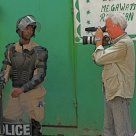WATCH ABOVE: A preview for 16×9’s “Resurrecting Species.”

Ben Novak is nothing if not relentless. When people told him he’s taken on an impossible task, he evoked Thomas Edison. “He failed making a light bulb something like 2000 times before he found a filament that would work.”
But Novak is trying to do something far more daunting than a light bulb. He wants to reverse nature, turn back the clock and bring a species back from the grave. Some might even call it a god-like conceit. Novak wants to resurrect the passenger pigeon, a bird that went extinct 73 years before he was born in a small South Dakota town.
The weight of science is against him, but the 27-year-old Novak paints his objective with a broad brush. “This is not driven by the need to bring back the passenger pigeon,” he says, surprisingly.
“This is about asking the right questions . . . We’re going to rewrite the history of a bird so that we can understand whether or not there’s a future. . . . We can use this species to open a door.”
As a boy, Novak was a bit of a nerd. He was fascinated by dinosaurs and dodo birds. He was intrigued by extinction like the woolly mammoth and the Tasmanian tiger. But when he saw a stuffed passenger pigeon at the Smithsonian, he was hooked. He decided this would be his life’s work.
The pigeon, stiff on a perch, gave Novak a glimpse of an exciting future, where bird breeders, geneticists, biotechnologists and computational biologists would pool their skills and bring back vanished life.
He’s still young enough to use the word “neat.” “I think that’s a really neat dynamic that we’ve started with this project.”
The “we” in this case includes an intriguing character from the 1960s: Stewart Brand, a California counter-culture icon who produced, among other things, The Whole Earth Catalog. In 1996, Brand started the Long Now Foundation, which set out to design things like a clock that would tell the time for 10,000 years, and a disk inscribed with 1500 languages that was shot into space aimed at a comet 500 million miles away.
It was after three years of big loopy concepts that Brand came up with his biggest idea: to bring back a creature that once filled the skies of eastern Canada and the U.S. When the Europeans first arrived in North America, there were between 3 and 5 billion passenger pigeons.They were extinct by 1914.
Today, Brand reckoned, de-extinction was within reach, thanks to genome-editing technology: designing the DNA blueprint of a creature no longer living. Reviving the pigeon, he said, would be a “beacon of hope for conservation.”
Shortly thereafter Ben Novak jumped on board. His scientific credentials did not quite match his zeal. He studied ecology in college and has no advanced degrees. However, he is bright, tireless and well-spoken. It doesn’t hurt that he has the touch of the poet, as when he rhapsodizes about the elegant dance of the passenger pigeon with the forest. Trees more than a century old, he says, remember the weight of the pigeons on their branches.
WATCH BELOW: Ben Novak’s life work is the passenger pigeon – an extinct bird he hopes to “resurrect” by sequencing its DNA. Here he speaks with lifelong animal lover and author on endangered birds, Michele Raffin.
Novak is surrounded by skeptics, including experts like Beth Shapiro, an evolutionary biologist at the paleogenomics lab at the University of California. Shapiro has been sequencing the passenger pigeon’s DNA since 2001, for reasons other than de-extinction. She thinks Novak’s project is “silly” and she’s not afraid to say it.
“People like the idea that extinction’s not forever,” she told 16×9. “Perhaps we could turn back the clock and defy science . . . It’s not possible but it’s exciting. I mean, Jurassic Park was an enormous hit.”
Every summer, Shapiro visits the Yukon searching for mammoth bones.
“We’re not going to bring back a woolly mammoth or passenger pigeon but we can understand what some of their genes are . . . and we can bring back those traits, we can manipulate genetically a living animal to be able to express some of the traits of those species that are extinct.”
In other words, we may be able to build a better elephant or a better pigeon, by introducing characteristics from an extinct species.
The only time a creature became “un-extinct” was in 2009, when scientists bred a Spanish goat called a bucardo from the stem cells of a dead female. The animal lived for seven minutes.
Ben Novak has greater expectations. He hopes that in his old age he will be able look up and see small flocks of passenger pigeons flying overhead; “blue meteors” as they used to be called.
“It’s a book being written,” he says about evolution, “but you never know what the next sentence is because we’re not the people who write it.”
Novak says he is happy to at least have contributed to a possible opening chapter.
16×9’s “Resurrecting Species” airs this Saturday at 7pm.















Comments